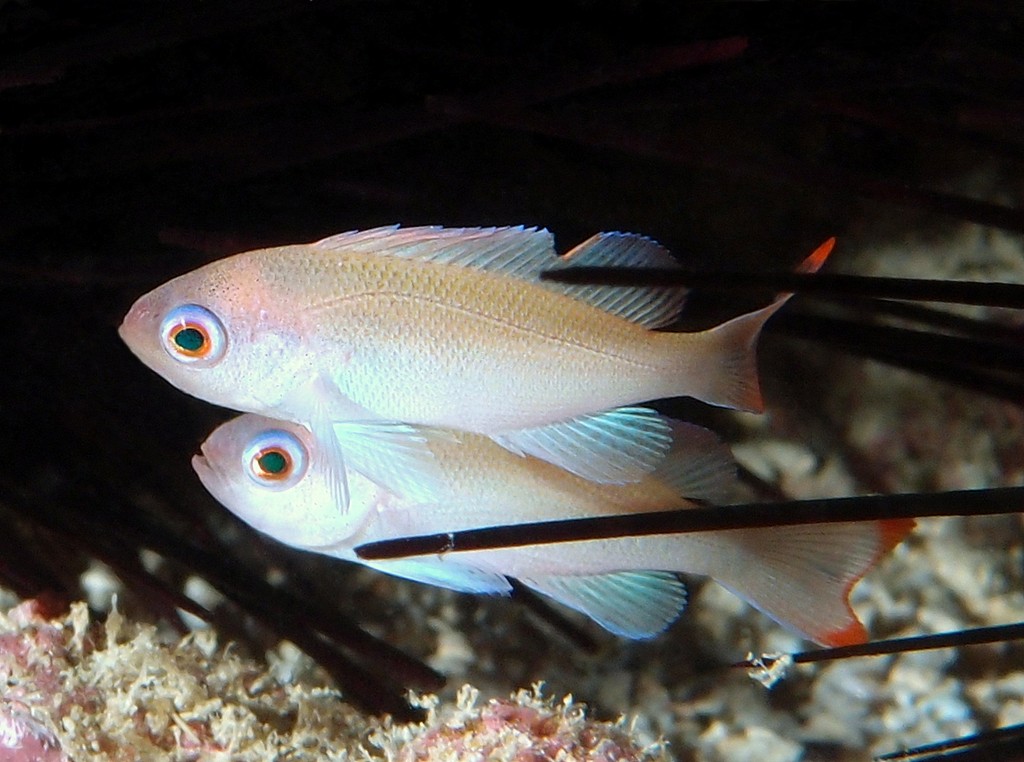PSEUDANTHIAS HYPSELOSOMA - (BLEEKER, 1878)
Actinopterygii (Gigaclass) > Actinopteri (Class) > Teleostei (Subclass) > Perciformes (Order) > Percoidei (Suborder) > Anthiadidae (Family) > Pseudanthias (Genus)
Anthias rose, Pink basslet, Pink seaperch, Stocky anthias, Keramahanadai, ケラマハナダイ, 截尾花鮨, 高體擬花鮨,
Synonymes
Anthias hypselosoma (Bleeker, 1878)
Anthias truncatus (Katayama & Masuda, 1983)
Pseudanthias hypeelosoma (Bleeker, 1878)
Pseudanthias truncatus (Katayama & Masuda, 1983)
-------------------------
Description
Dorsal spines (total): 10; Dorsal soft rays (total): 15-17 (usually: 16, rarely: 15); Anal spines: 3; Anal soft rays: 7; Pectoral fin rays: 18-20; Caudal: 15; Vertebrae: 26 (11 + 15); Gill rakers: 10-13 + 26-30; Lateral-line scales: 44-48; Body depth: 2.5-3.0 in SL; No papillae on margin of orbit; Subopercle and interopercle serrate; Fourth to tenth dorsal spine subequal; Caudal fin of females slightly emarginate, of males truncate with slightly prolonged lobes at corner; Pelvic fin not reaching anal fin. Max. length: 19.0 cm TL, common length: 15.0 cm TL. Depth range: 6 - 50 m.
Color
Scales dorsally on body with yellow centres and magenta to lavender edges, nearly white ventrally; Females with a bright red posterior margin on caudal fin which is brader at corner; Males with a red blotch abassly in dorsal fin between seventh ant tenth spines.
Etymology
Pseudanthias: from Greek, pseudes = false + from Greek, anthias = a name of an unknow fish given by Aristotle in "History of Animals". This book, written in the fourth century BC, is one of the major texts on biology by the ancient Greek philosopher Aristotle (384–322 BC), who had studied at Plato's Academy in Athens.
hypselosoma: from Greek, hypselos = high + from Greek, soma = body. Referring to “less stocky” (translation, from Bleeker 1878) body compared to Pseudanthias manadensis.
Original description: Pseudanthias hypselosoma Bleeker, 1878 - Type locality: New Guinea.
Distribution
Indo-West Pacific: Maldives east to Samoa and Palau, north to Kagoshima Prefecture (southern Japan), south to Queensland (Australia) and New Caledonia.
Anthias rose, Pink basslet, Pink seaperch, Stocky anthias, Keramahanadai, ケラマハナダイ, 截尾花鮨, 高體擬花鮨,
Synonymes
Anthias hypselosoma (Bleeker, 1878)
Anthias truncatus (Katayama & Masuda, 1983)
Pseudanthias hypeelosoma (Bleeker, 1878)
Pseudanthias truncatus (Katayama & Masuda, 1983)
-------------------------
Description
Dorsal spines (total): 10; Dorsal soft rays (total): 15-17 (usually: 16, rarely: 15); Anal spines: 3; Anal soft rays: 7; Pectoral fin rays: 18-20; Caudal: 15; Vertebrae: 26 (11 + 15); Gill rakers: 10-13 + 26-30; Lateral-line scales: 44-48; Body depth: 2.5-3.0 in SL; No papillae on margin of orbit; Subopercle and interopercle serrate; Fourth to tenth dorsal spine subequal; Caudal fin of females slightly emarginate, of males truncate with slightly prolonged lobes at corner; Pelvic fin not reaching anal fin. Max. length: 19.0 cm TL, common length: 15.0 cm TL. Depth range: 6 - 50 m.
Color
Scales dorsally on body with yellow centres and magenta to lavender edges, nearly white ventrally; Females with a bright red posterior margin on caudal fin which is brader at corner; Males with a red blotch abassly in dorsal fin between seventh ant tenth spines.
Etymology
Pseudanthias: from Greek, pseudes = false + from Greek, anthias = a name of an unknow fish given by Aristotle in "History of Animals". This book, written in the fourth century BC, is one of the major texts on biology by the ancient Greek philosopher Aristotle (384–322 BC), who had studied at Plato's Academy in Athens.
hypselosoma: from Greek, hypselos = high + from Greek, soma = body. Referring to “less stocky” (translation, from Bleeker 1878) body compared to Pseudanthias manadensis.
Original description: Pseudanthias hypselosoma Bleeker, 1878 - Type locality: New Guinea.
Distribution
Indo-West Pacific: Maldives east to Samoa and Palau, north to Kagoshima Prefecture (southern Japan), south to Queensland (Australia) and New Caledonia.
Biology
Found inshore. Usually occurs in groups on well-protected reefs of lagoons or bays.
Found inshore. Usually occurs in groups on well-protected reefs of lagoons or bays.
Similar species
Pseudanthias rubrizonatus (Randall, 1983) - Reported from New Caledonia (Loyalty Islands). Female are similar in color.
Pseudanthias rubrizonatus (Randall, 1983) - Reported from New Caledonia (Loyalty Islands). Female are similar in color.
Last update: 2, September 2022
